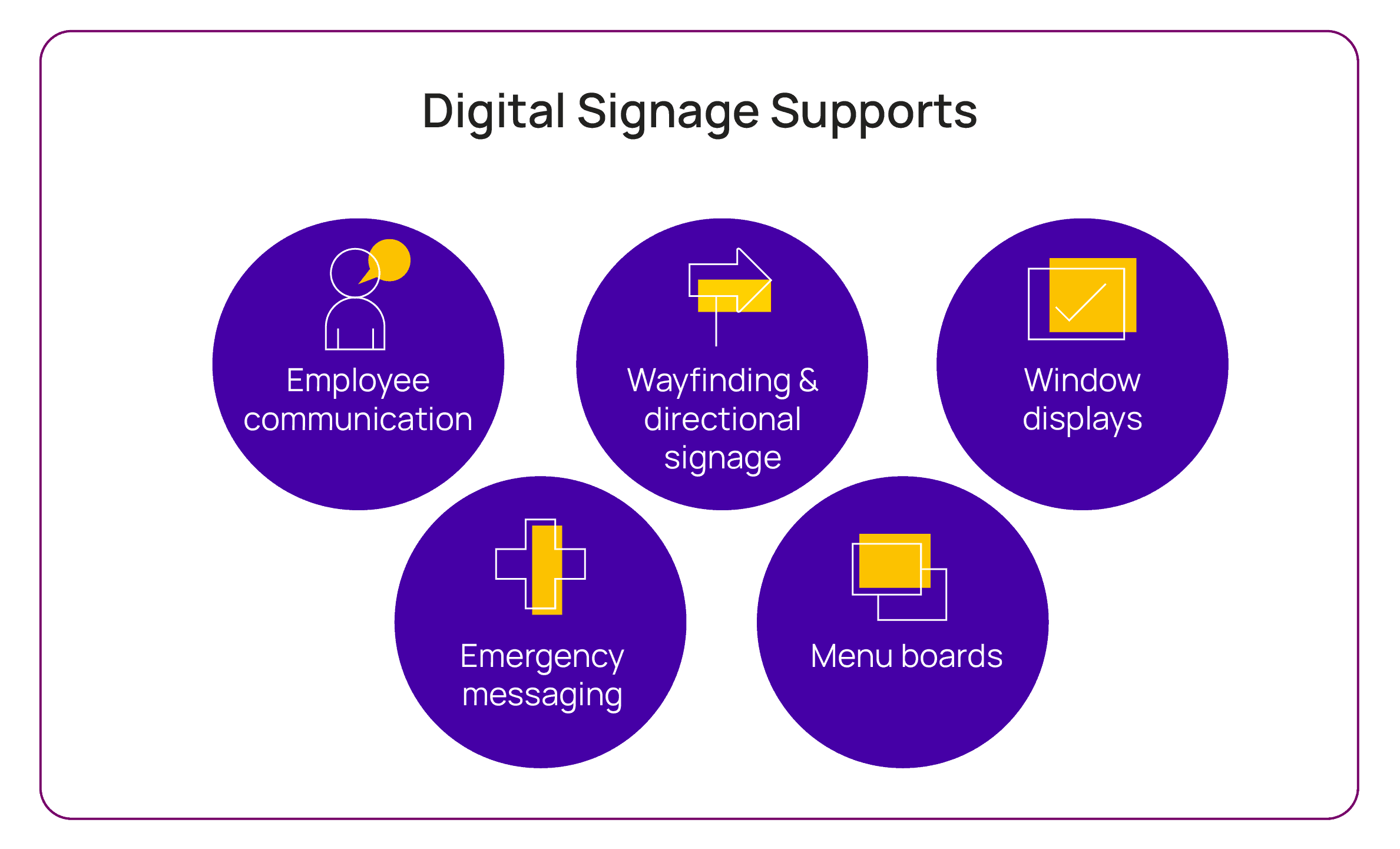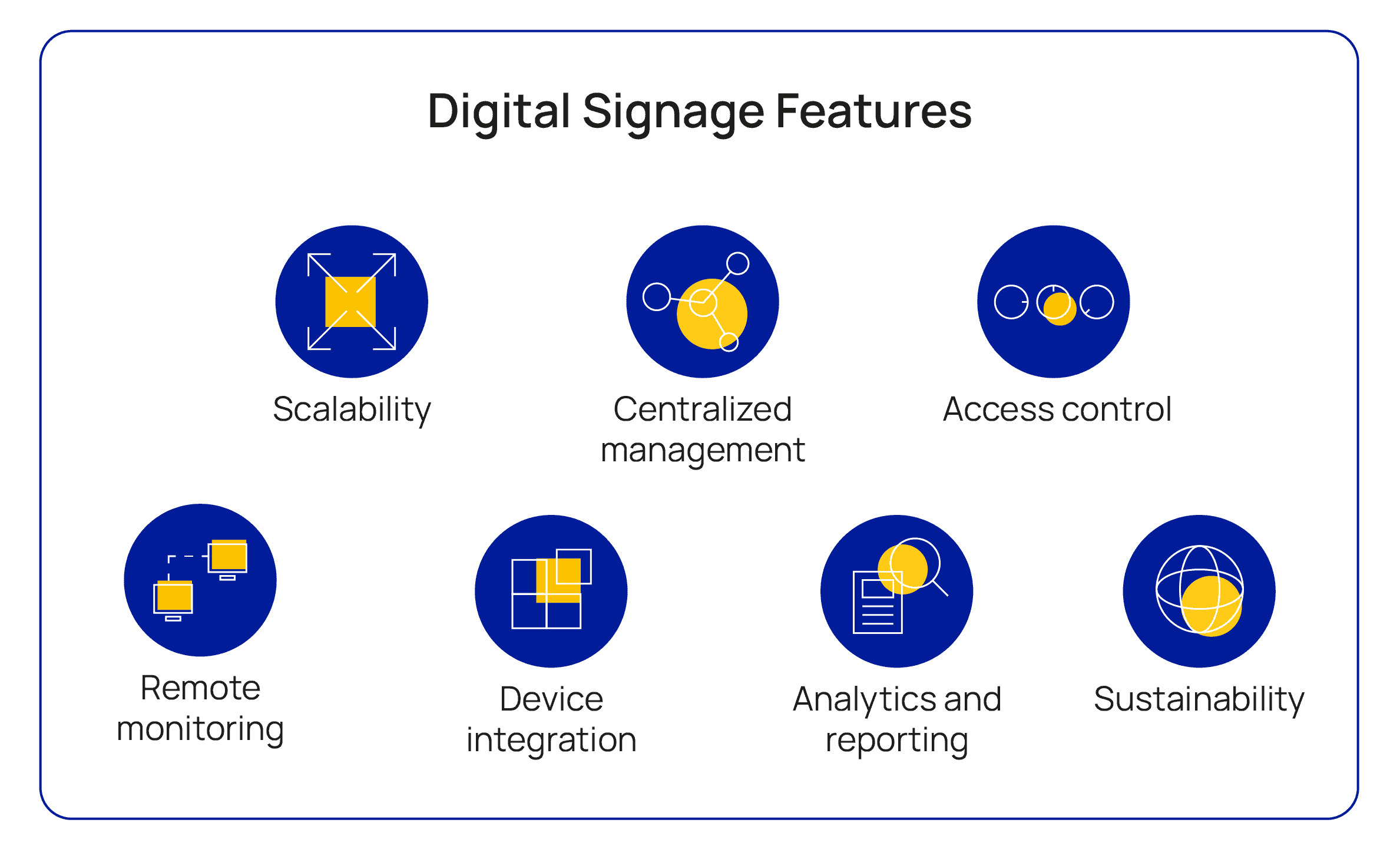Digital Signage
What is Digital Signage?
Digital signage utilizes electronic displays to deliver customized content and messages to a target audience. This form of visual communication leverages digital technology to display dynamic, interactive content, including videos, images, text, and animations.
In modern business environments, digital signage has become a powerful tool due to its ability to capture attention, engage viewers, and deliver targeted messages. One key advantage is its flexibility and adaptability; unlike traditional static signage, digital displays can be updated in real-time, allowing businesses to tailor messaging based on specific timeframes, locations, or customer demographics.
Related Content
Secure and control displays with IGEL on the endpoint
LG and IGEL spearhead a dynamic digital signage solution
How does Digital Signage work?
Digital signage is a network of interconnected digital displays that serve a variety of purposes, such as delivering targeted information, entertainment, merchandising, and advertising. Using display technologies such as LED walls, projection, and LCD monitors, digital signage can be managed from a central location allowing messaging to be adjusted to meet the unique needs of targeted audiences at any given time.
Digital signage networks can be as simple or as complex as desired by the business, scaling from controlling one, two, or three screens up to any preferred number. Zoning features make it possible to send the same digital content to multiple screens or just a handful.
While digital signage was once seen as a technical tool requiring IT support, content management platforms are now designed with the needs of marketing or communications teams in mind, allowing for simple updating and control over content delivery. While some complex integration work may still be required for implementation, day-to-day operation should no longer be a technical challenge for most businesses.
Why is Digital Signage so prevalent across organizations?
Commercial signage has evolved from traditional static formats to dynamic digital signage. Traditional signage, such as hand-painted shop signs, billboards, and neon signs, played a crucial role in advertising but had limitations in capturing attention and delivering targeted messages.Digital signage targets and engages audiences more effectively than traditional static signage. Studies have shown, for example, that digital signage captures 400% more views than static signs1.
The digital revolution marked a significant shift, enabling businesses to display dynamic content that can be updated and tailored to specific audiences. Today, digital signage is at the forefront of commercial display solutions, with advancements in high-resolution displays, interactive touchscreens, and cloud-based content management systems creating captivating and personalized experiences for customers.
Trends in commercial signage include integrating artificial intelligence, augmented reality, and mobile connectivity. AI-powered signage analyzes customer behavior to deliver targeted content in real-time, while augmented reality enhances engagement by overlaying digital information onto the physical world. Mobile connectivity allows seamless integration with customers’ smartphones for a more interactive experience.
Digital Signage Use Cases
Digital signage can be used in any location where static signs are currently used. Because digital signage is so engaging, there are countless opportunities to utilize it across many organizations and industries.
- Healthcare – enhance the patient experience and provide helpful information.
- Financial Services – elevate customer communications through targeted, informative messaging delivered in real-time.
- Retail – improve the customer experience, promote offers and discounts can help increase sales.
- Manufacturing – frontline communications, share KPIs, process steps, and updates on the shop floor and production line.
- Transport – wayfinder through terminals to check-in kiosks, and gates, flight information displays (FIDS)

Digital Signage Features
Effective digital signage relies on several key components, from hardware to software. High-quality displays and media players are essential for delivering eye-catching content. The displays provide vibrant colors and sharp images, while media players ensure smooth playback and seamless transitions. IGEL OS offers a robust security layer that ensures digital signage operates safely and efficiently for a better user experience.

Digital Signage Benefits
According to researchers, 90% of the information transmitted to the brain is visual2 and the human brain can identify images seen for as little as 13 milliseconds. As such, digital signage plays a critical role in boosting brand visibility and enhancing customer awareness, as it enables the delivery of captivating content within minutes, creating unique user experiences on a large scale. Notably, 80% of brands that use digital signage record an increase in sales.3. As such, digital signage plays a critical role in boosting brand visibility and enhancing customer awareness, as it enables the delivery of captivating content within minutes, creating unique user experiences on a large scale. Notably, 80% of brands that use digital signage record an increase in sales4.
Digital signage provides numerous benefits that enhance business operations and customer experiences:
- Enhanced visual communication: Digital signage captivates audiences with vibrant, eye-catching visuals, ensuring messages are visually appealing and grab attention.
- Increased customer engagement: Interactive digital signs create personalized experiences, enabling customers to explore and interact with content, products, or services more immersively.
- Efficient management and scheduling: Centralized management systems enable easy control and scheduling of content across multiple displays, ensuring consistency and timely message delivery.
- Real-time content updates: Digital signage allows quick and easy content updates in real-time, adapting messaging to suit changing business needs, promotions, or events.
- Cost-effectiveness and ROI: Digital signage reduces printing and distribution costs associated with traditional advertising methods, offering better ROI tracking and marketing optimization.
By leveraging digital signage solutions, businesses can transform communications, engage employees and customers, improve employee engagement and maximize marketing efforts.
